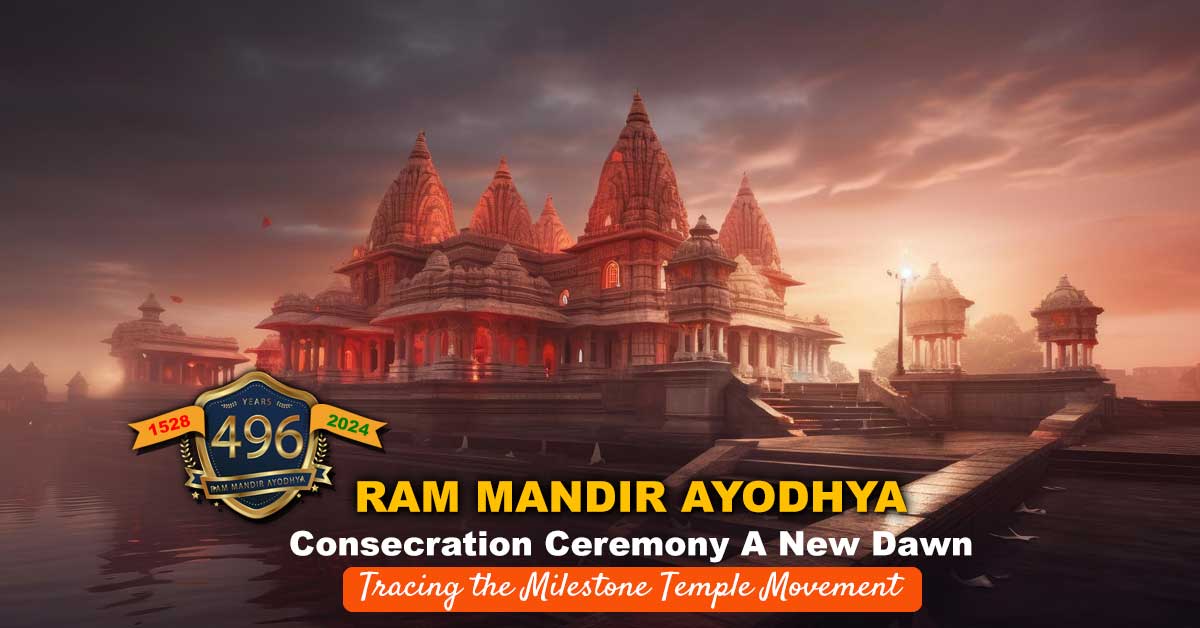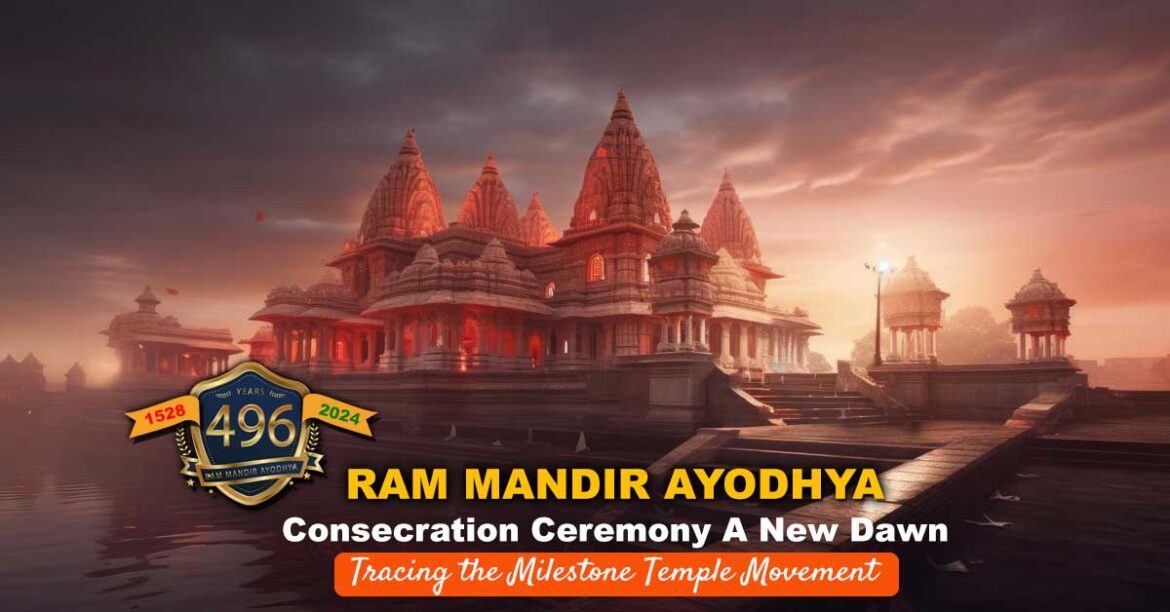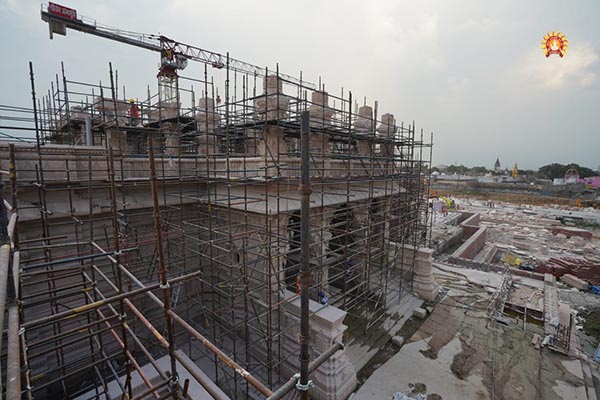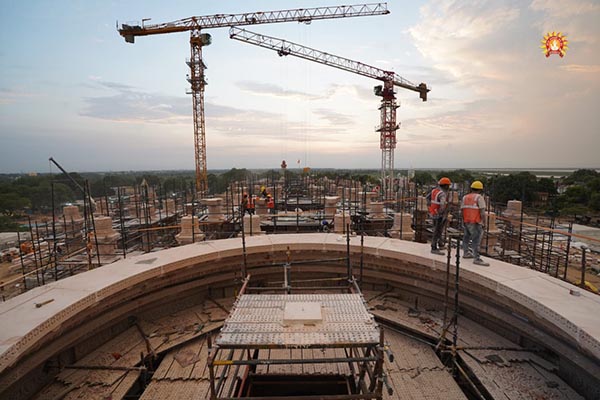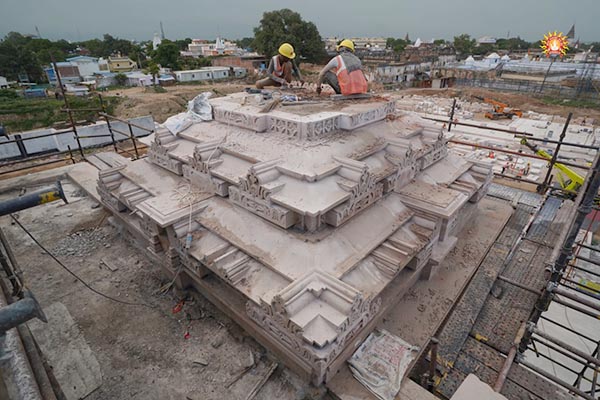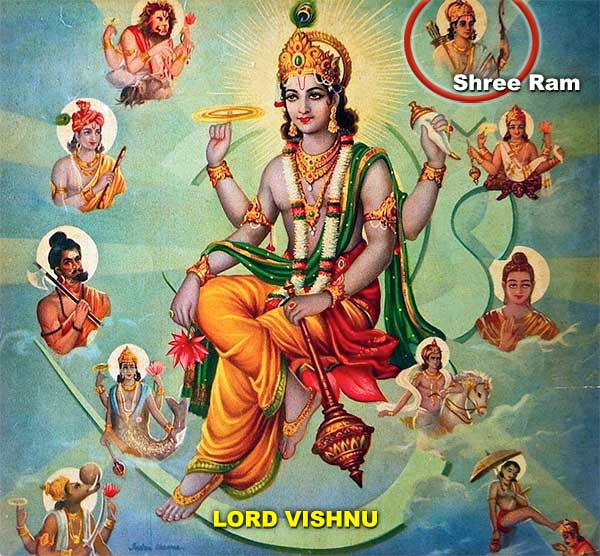The temple Bells are ringing. The air in Ayodhya crackles with the echo of chants- “Jai Shri Ram” and the scent of incense. The Ram Mandir Ayodhya: Consecration of a new dawn for India. The Ram temple symbolises pride, a place of worship for the devout. Witness the history being made on Ayodhya Ram Mandir Opening Date- 22nd Janurary.
The consecration ceremony at the Ayodhya Ram Temple is the culmination of over 496 years of struggle and the dawn of a new era for India. The occasion symbolized the reinstated worship of the revered “Ram Lalla” at his place of birth. Embarking on religious tourism as we explore the divine allure of Ayodhya Ram Mandir
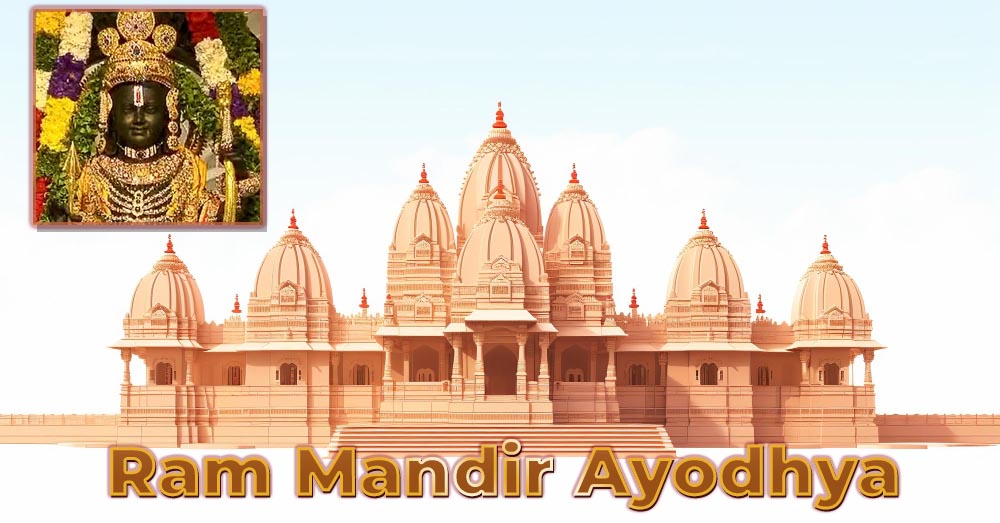
The global search is abuzz with the question: Where is Ram Mandir located? The current trending query on the internet revolves around the exact match: “What is the cost of Ram Mandir in Ayodhya, and who is funding Ram Mandir construction?” With this in-depth exploration we trace the 496 years of milestones of temple movements (1528-2024).
Today, Ayodhya rises like never before. This article explores the Socioeconomic transformation of the holy city of Ayodhya- Ram Janmabhoomi. The prana pratishtha is a ritual of life, a moment that will end all strife. For a nation grappling with its past and dreaming of its future.
We’ll weave together the echoes of history with the whispers of tomorrow to ask. Join us as we explore the possibilities, complexities, and hopes arising from the sacred Ram Janmabhoomi.
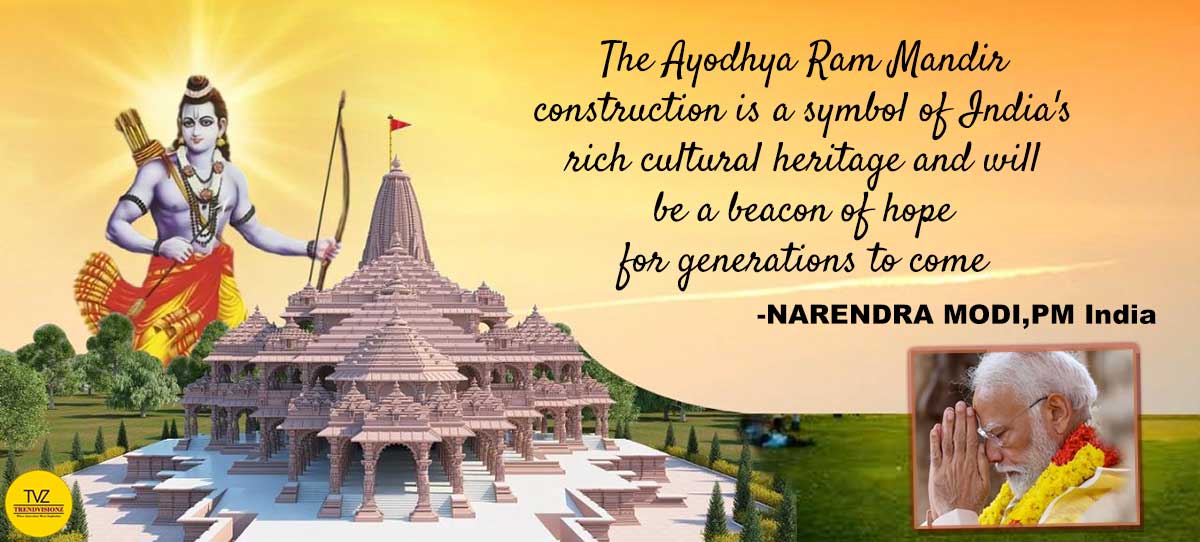
Today, in the sacred land of Ayodhya, Lord Ram has graced his magnificent temple. On this auspicious occasion, I urge all fellow citizens to illuminate their homes with the divine “Ramjyoti” Jai Siya Ram!
Shri Narendra Modi, Prime Minister of India
Also Read:
- Bell of Mindfulness: Your Ultimate Path to Stress-Free Living
- The Birth and Blessings of Khatu Shyam Ji: A Divine Protector
The Grand Consecration Ceremony: Ram Mandir Ayodhya
The Prana Pratishtha, a ritual of Life, The Idol of Ram Lalla brought to Life,
A Moment of Joy, a Moment of Strife, A Moment that will end all Strife

After decades of anticipation, the grand consecration ceremony for the majestic Ayodhya Ram Mandir finally occurred on January 22, 2024.
Meaning of “Prana Pratishtha”
Prāṇa signifies “life force, breath, spirit” in Sanskrit. Pratiṣṭhā is commonly interpreted as “installed” or “consecrated” in general usage. The expression Prana Pratishtha refers to a ritual that signifies the “establishment of the image in its vital breath” or the “bringing of life to the temple.” In simpler terms, it is synonymous with Murti Sthapana.
‘Ramotsav’: Prelude to the Main Event
The Uttar Pradesh government allocated ₹100 crore (US$13 million) for ‘Ramotsav.’ The religious event series involves 826 local authorities before the Prana Pratishtha (consecration) ceremony. Spanning from December 2023 to the significant ceremonies on January 16, 2024 (Makar Sankranti). And the inauguration of the Ram Mandir on January 22, 2024, the events retraced Shree Ram’s 14-year banishment. The event saw participation from diverse sectors, including actors, scientists, people in business, and spiritual leaders.
Consecration Ceremony: Ayodhya Ram Mandir Opening Date
On January 22, 2024, the Pran Pratishtha ceremony occurred at the Ram Mandir Ayodhya. The highlight of the Shree Ram Janmaboomi Temple ceremony in Ayodhya, Uttar Pradesh, was the installation of the idol of Ram Lalla in the sanctum sanctorum around noon. Accompanied by the divine sounds of traditional instruments resonating across Ayodhya.
A Momentous Occasion, A Story of Faith and Devotion
Auspicious Alignment: Why 22 Hanuary is Choosen
Astrologically significant, January 22nd aligns with ‘Karma Dwadashi’ in the Hindu calendar, the Dwadashi date of ‘Shukla Paksha’ in ‘Pausha’ month. This auspicious date for the Pran Pratistha ceremony at Ram Mandir synchronizes with ‘Mrigashira Nakshatra,’ ‘Amrit Siddhi Yoga,’ and ‘Sarvartha Siddhi Yoga,’ marking a spiritually powerful commencement. Vedic astrology emphasizes the auspicious Abhijit Muhurat from 12:16 pm to 12:59 pm IST.
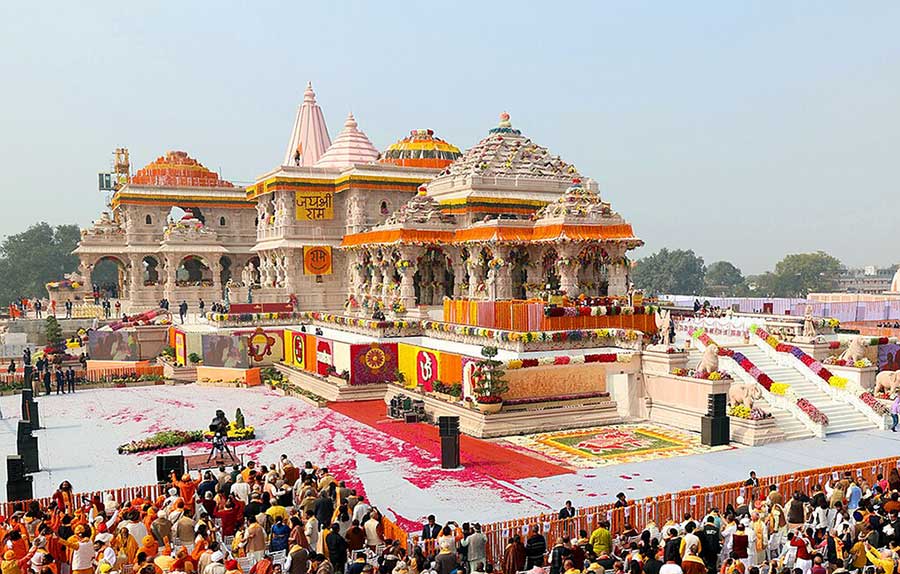
Schedule of Pran Pratishtha Ceremony for Ram Mandir Inauguration
- The auspicious Prana Pratishtha ceremony started at 12:20 pm with Vedic chants by priests and the chanting of mantras. Prime Minister Modi arrives by chopper at Ayodhya
- At 12:40 pm, the idol of infant Ram Lalla was brought to the sanctum sanctorum for installation. The idol was carved out of a single black touchstone block.
- The Prana Pratishtha ritual was completed by 1 pm, marking the formal consecration of the temple.
- The ‘Mool Muhurt,’ the auspicious time for the consecration ritual, was for 84 seconds. PM Modi unveil the idol’s eyes and applied kajal with a thin gold stick. A small mirror was presented to Diety. The ‘Maha arti,’ with the lighting of 108 diyas, concluded the event.
- The musical accompaniment to the ceremony was provided by over 50 traditional instruments from various states of India.
- Renowned musician Pandit Yatindra Mishra composed and conducted this extraordinary Mangal Dhwani rendition for over two hours.
- The entire ceremony was telecast live for devotees across India and the world, enabling them to participate in this historic moment.
- For the “Pran Pratishtha” ceremony over 6,000 invitations were sent for Ram Mandir consecration. Event marked by the presence of prominent figures such as Amitabh Bachchan, Mukesh Ambani, and Baba Ramdev. Also seen were Sachin Tendulkar, Virat Kohli, Ratan Tata and Gauam Adani.
- Notable absentees: Congress and Communist Party leaders, as well as all four Shankaracharyas.
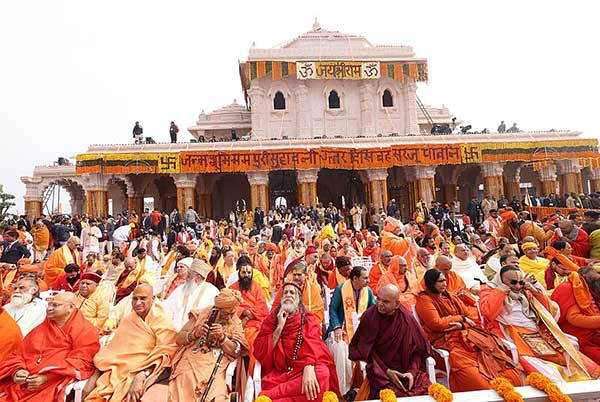
For millions of Hindus, this ceremony marked the culmination of their decades-long dream to see a grand Ram Mandir at the holy site in Ayodhya. The consecration has set the stage for regular worship and darshan at the temple for generations.
Future Construction Plans
Following the momentous Pran Pratistha ceremony on January 22, Nripendra Mishra, Chairman of the Ayodhya Ram Temple Construction Committee, has revealed insights into the upcoming phases of temple construction. Emphasizing their dedication,the trust is commits to finalize the entire temple construction by 2024.
Also Read:
- What is Gen AI: Decoding The Ultimate Future of Marketing Creativity
- Tech Skills Companies Crave: How to Future-Proof Your Career
- Secrets of Lasting Happiness: Your Guide to True Joy
What is the Significance of Ram Mandir Ayodhya
Let’s delve into “why Ram Mandir is Important?”.
Ayodhya District Map
The birthplace of Lord Rama, Ayodhya, is an ancient city on the banks of river Saryu in Uttar Pradesh. Ayodhya was the capital of the historic Kosala Kingdom in ancient times. Spanning an area of 2522 square kilometres, Ayodhya signifies its demographic landscape. As of 2024, the estimated population of Ayodhya District is around 78,000.

It is one of the Seven most revered pilgrimage destinations (Mokshdayini Sapt Puris) worshipped by Hindus. Ayodhya is mentioned in ancient Hindu scriptures of Ramayana and Puranas as the capital of the Ikshvaku dynasty or Sūryavaṃśa (Descendants of the Sun, Hindi: सूर्यवंश)
- Ancient Inhabitation: Archeological evidence suggests Ayodhya was inhabited since at least the 6th century BCE.
- Center of Vaishnavism: Between the 6th century BCE and the 16th century CE, Ayodhya was ruled by various Hindu and Muslim dynasties.
- Buddhist Connection: The present-day city is identified with Saketa, described in Buddhist texts dating back to the 5th century BCE. Sākēta (Sanskrit: साकेत) refers to the ancient Indian city of Ayodhya.
- Temple Construction: The construction of a grand Rama temple is in the first phase.
- Global Appeal: The construction of the Ram Mandir garnered national and international attention, with contributions from devotees worldwide. This global support highlights the universal reverence and cultural significance beyond national boundaries.
Ram Mandir Ayodhya honours Lord Ram (the seventh incarnation of Lord Vishnu) and is revered for his virtues of compassion, courage and devotion to dharma. The fascinating genealogy is woven into the fabric of an ancient dynasty, stretching back to the very origins of humankind. The historic Ram Mandir Ayodhya provides an opportunity to build bridges, not walls.
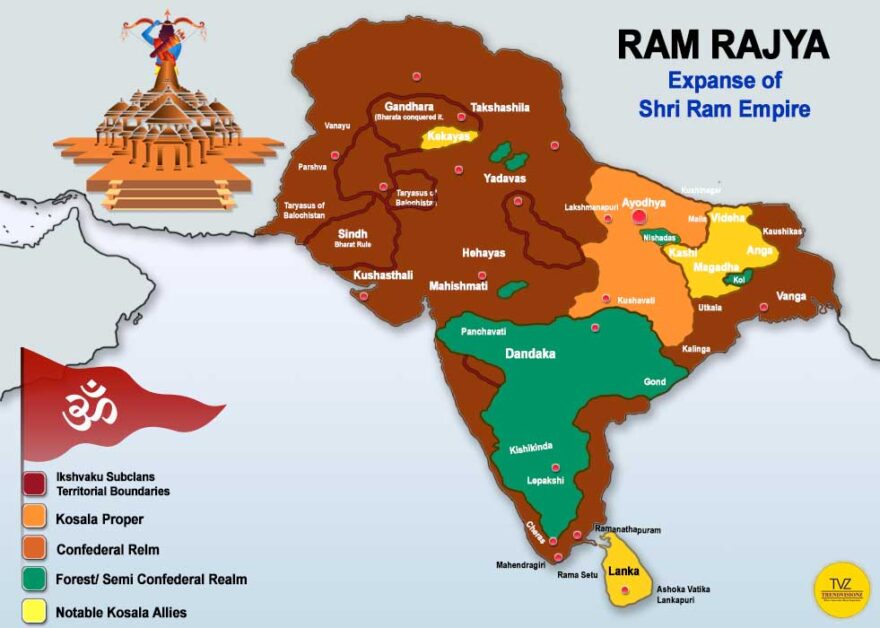
Ayodhya Ram Mandir History: Key Events (1528-2024)
The Ram Janmabhoomi debate culminated in the construction of the Ram Mandir Ayodhya. The events are deeply woven into India’s religious and political landscape. Here’s a brief glimpse of the milestone historical events of UP Ram Mandir the version most widely acknowledged in official government gazettes.
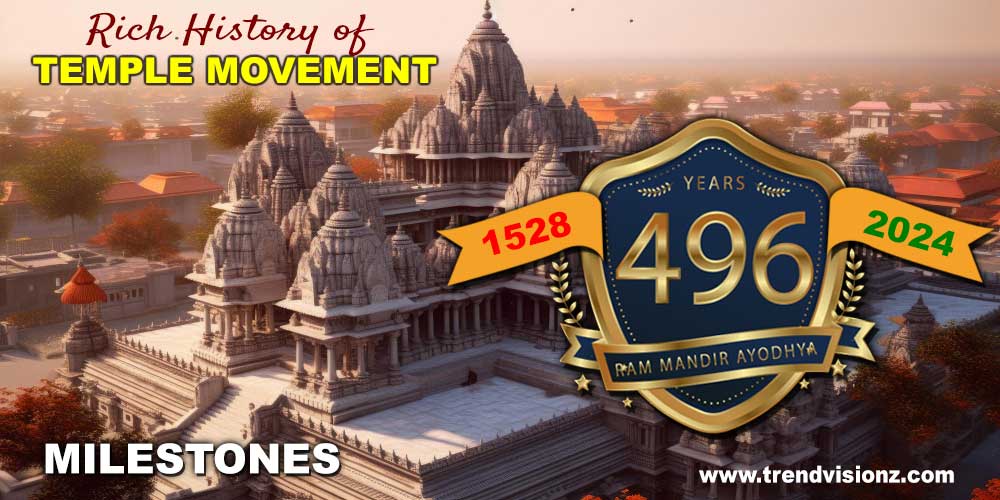
Key Historical Events: Ayodhya Ram Mandir:
Early Claims:
For centuries, Hindus revered Ram Janmabhoomi in Ayodhya as the birthplace of Lord Rama. A central figure in Ramayana, Lord Rama is a venerated deity in Hinduism
- 1528: Babri Masjid’s Origin. The Babri Masjid was built in Ayodhya between 1528-1529 CE by Baqi Tashqandi (also Mir Baqi), a commander under Mughal emperor Babur. The disputed structure on the temple’s remains was the foundation for future disputes.
- 1751 First Claim. Marathas seek control of Ayodhya, Kashi, and Mathura, introducing new dimensions to the simmering conflict.
- 1858 Nihang Sikh Demands. Nihang Sikhs attempt to claim Babri Masjid as Lord Ram’s birthplace
- 1885: The First Legal Claim: Raghubar Das files the initial legal suit, initiating a precedent that sustained the dispute for decades.
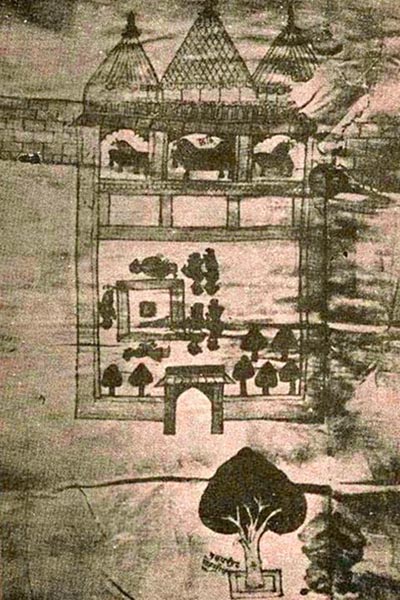
Simmering Tensions:
Throughout the 19th and early 20th centuries, sporadic disputes arose regarding access to the site.
Turning Point:
- 1949: ‘Ram Lalla’ Idols Inside Babri Masjid. The placement of ‘Ram Lalla’ idols intensifies religious sentiments, triggering the first legal battles over ownership.
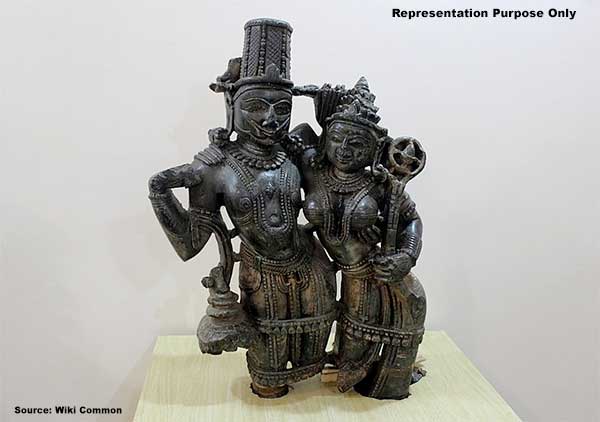
- 1950-1959: Legal Suits Multiply. A surge in legal suits sees Nirmohi Akhara seeking worship rights and the Sunni Central Waqf Board seeking possession.
Rising Movement:
A nationwide campaign for building a Ram Janmabhoomi temple. This “Ram Janmabhoomi movement” gained immense popular support, particularly among Hindus.
- 1986-1989: Babri Masjid Locks Opened. The controversial unlocking of the Babri Masjid in 1986 became pivotal, fueling tensions.
- 1990: Rath Yatra and Failed Demolition Attempt. L.K. Advani’s Rath Yatra 1990 escalated demands for a temple, culminating in a failed demolition attempt.
Escalation and “the Tragedy”:
- 1992: The Infamous Demolition. The Babri Masjid’s demolition in 1992 became a seismic shift, altering the landscape of Indian politics.

- 1993-1994: Post-Demolition Riots. Communal riots erupt across India following the demolition, prompting legal interventions.
- 2002-2003: ASI’s Excavation and Allahabad High Court Hearing. The Allahabad High Court heard the title case in 2002, with ASI claiming evidence of a Hindu temple beneath the mosque.
- 2009-10: Liberhan Report Submission. The Liberhan Commission’s report in 2009 implicates key leaders, and the Allahabad High Court’s 2010 verdict attempts to settle the dispute.
Legal Battle and Resolution:
Years of legal proceedings followed, culminating in the landmark Supreme Court verdict of November 2019.
- 2019: Supreme Court’s Historic Judgment. The Supreme Court awards the disputed land to Hindus for the Ram Temple and allocates an alternate site for a mosque.
A New Chapter:
With the Supreme Court’s verdict and the ongoing construction of the Ram Mandir, a new chapter in this long-standing dispute has begun
- 2020: Bhoomi Pujan at ‘Shri Ram Janmabhoomi Mandir’. PM Modi lays the foundation stone for the Ram Temple, signalling the beginning of construction.
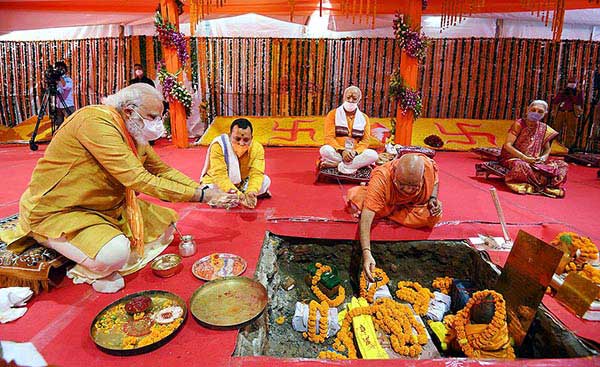
2024: PM Modi Inaugurates The Ram Temple. PM Modi leads the Pran Pratishtha (consecration ceremony), bringing a semblance of closure to the protracted legal saga of over 496 years.

A new chapter of unity and shared heritage is on offer for the nation. The legal odyssey, though tumultuous, ultimately paved the way for a harmonious resolution.
Architectural Marvel: Ayodhya’s Ram Mandir
Ayodhya’s Ram Mandir is a testament to architectural brilliance, blending ancient Hindu traditions with modern technology.
- Chief Architect: Chandrakant B. Sompura (CBS),
- Construction Company: Larsen and Toubro (L&T)
- Project Manager: Tata Consulting Engineers Limited (TCEL)
Architectural and Design Features:
Temple Design and Inspiration:
The Ram Mandir Ayodhya, spans 2.77 acres in a lush 70-acre area. The temple embraces the Nagara architectural style. A hallmark of traditional northern Indian Hindu temple design. With a height of 161 feet, width of 250 feet, and length of 380 feet, it echoes ancient grandeur while incorporating modern elements. The vision, shaped by the Chief Architect in an interview to NDTV, reflects meticulous planning outlined over three decades.
Symbolism in Materials, Layout, and Motifs:
The temple’s construction employs high-grade “Rolled Compacted Concrete” without steel, showcasing durability and adherence to Vedic principles. Pink sandstone, granite, and Shaligram rock and copper plates contribute to the temple’s sacred aura.

The Shri Ram Janmabhoomi Temple in Ayodhya is constructed using specially crafted “Shri Ram 2023” bricks, commemorating the year of its construction. These bricks undergo a unique process, ensuring enhanced strength and durability. The use of gold and Ashtdhatu adds a touch of divine luxury. The layout incorporates a green area of 70%, fostering a serene environment.
Foundation Design:
The foundation, a crucial element, comprises 14-meter thick Rolled Compacted Concrete resembling artificial stone. A plinth of 21 feet, made of granite, safeguards the temple from moisture. Materials like granite from Karnataka & Telangana and 17,000 m3 (600,000 cu ft) of sandstone from Baansi in Rajasthan. Adorned with Makrana marble, the identical stone employed in constructing the Taj Mahal. The temple’s doors and windows are crafted from Teak wood sourced from Maharashtra’s Chandrapur,
Building Description:
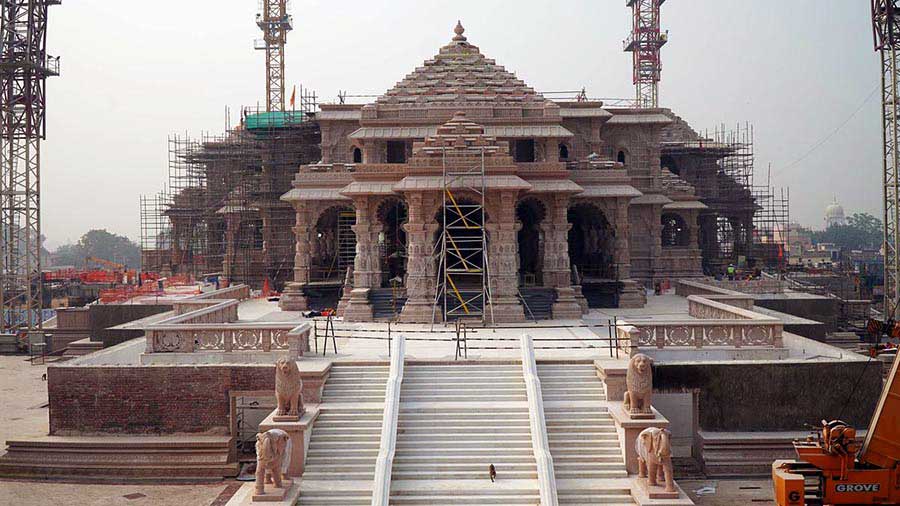
A 3-storied earthquake-resistant structure, the temple features 392 pillars, 44 doors, and teakwood doors plated in gold. The bell made of Astadhatu and weighing 2100 Kg, resonates up to 15 Km. In total, the temple boasts 366 columns, with each column adorned by 16 idols. These idols encompass various representations, including the incarnations of Shiva, the 10 Dashavataras, the Chausath Yoginis, and the 12 manifestations of the goddess Saraswati.
Other Features:
Constructed on an elevated platform with three stories, the central structure of the temple features five mandapas within the Garbha Griha (sanctum sanctorum) and entrance passage. Embracing Nagara style, the Kudu, Nritya, Rang, Kirtan, and Prarthana mandapas are adorned with ornate Shikhara.
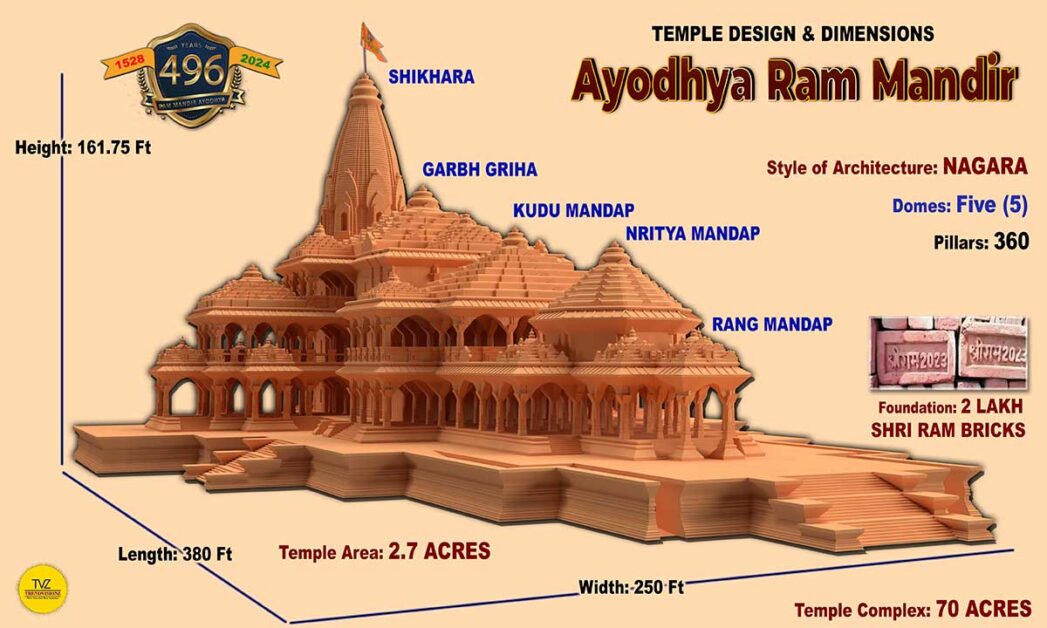
Surrounding temples pay homage to deities like Suryadev, Mother Bhagwati, Lord Ganesha, and Lord Shiva. Additionally, including Sita Kup and the renovation of the ancient temple of Lord Shiva on Navratna Kubera Hill showcase a holistic approach to religious architecture.
Ayodhya’s Ram Mandir is a harmonious blend of modern-day tribute to tradition and technology. A living testimony to the rich heritage of Hindu temple architecture
“Balak Ram”: Ayodhya Ram Mandir
The Ram Mandir in Ayodhya holds a unique significance as the “Ram Janambhoomi”. The conceptualization of the design of Lord Ram Temple Ayodhya-his birthplace embodies a vision. It captivates with its visual allure and also serves as a testament to the rich artistic heritage it showcases.
Child Form Significance
Choosing a five-year-old form aligns with Hindu beliefs, where children under 5 are considered innocent. The Child Form echoes the forgiveness of mistakes as stated by scholars like Chanakya.
Krishna Shila: Ram Lalla Idol
The 51-inch idol of Ram Lalla within Ayodhya Ram Mandir is a marvel.
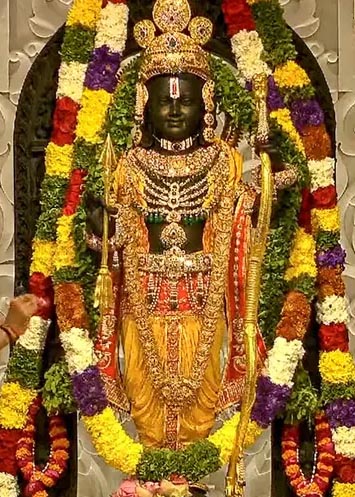
This stone, recognized for its dark colour, is named “Krishnashila.” Owing to its resemblance in colour to Lord Krishna. Mysore’s HD Kote serves as the central hub for Krishna Shila stone.
Ram Lalla Idol is intricately crafted from Krishna Shila stone. It is primarily composed of calcite, offering malleability for intricate patterns. It is said that the Krishna Shilla starts with a soft texture and gradually hardens over 2–3 years, ensuring durability. And is resistant to acid, heat, and harsh weather conditions, maintaining its integrity over time. During rituals like Abishekam with milk, the stone remains unreactive.
A Divine Representation of 10 Avatars
Depicting Lord Ram as a five-year-old child standing on a lotus made from the same stone, the 200 kg idol measures 4.24 feet in height and 3 feet in width. What makes it truly special is the inclusion of all 10 Avatars of Lord Vishnu on its surface.
The above image showcases Matsya, Kurma, Varaha, Narasimha, Vaman, Parshuram, Ram, Krishna, Buddha, and Kalki odivine incarnations of Lord Vishnu. The revered diety at Ram Mandir Ayodhya is affectionately called “Balak Ram” or “Ram Lalla”
Journey to Divine Presence: Ram Lalla in Ram Mandir
Ram Lalla Virajman, the cherished infant embodiment of Lord Rama, stands as the central figure or the deity in the spiritual tapestry of the Ram Mandir. As an avatar of Vishnu, Ram Lalla holds a profound significance, shaping the temple’s sanctity.
- Tailor-Crafted Attire. Ram Lalla’s divine presence is adorned with attire meticulously stitched by tailors Bhagwat Prasad and Shankar Lal.
- Idols in Sanctum. Two idols of Ram Lalla, including a five-year-old form, are consecrated in the temple’s sanctum. The Ram Lalla idol, weigh around 150-200 kg and stands at a height of 4.24 ft (51 inch) with a width of 3 ft (36 inch)
You will have a standing idol of Ram Lalla, and also the ‘murti’ (idol) which appeared in 1949. Both idols will be at the ‘singhasan’ (throne)
Nripendra Misra, Chairman, Shri Ram Janmbhoomi Teerth Kshetra
- Sculptor. Renowned sculptor Arun Yogiraj from Mysore, Karnataka. He was selected after a voting process.
- Ornaments. Ram Lalla’s ornaments are meticulously crafted. Based on extensive research from scriptural texts, including Adhyatma Ramayana and Ramcharitmanas.
- Craftsmanship. Harsahaimal Shiamlal Jewellers in Lucknow has brought these ornaments to life, conceived by Shri Yatindra Mishra.
- Regal Attire. The idol dons Banarasi fabric garments—yellow dhoti and red pataka/angavastram—embellished with pure gold zari featuring Vaishnav symbols.
- Crown and Jewellery. The gold crown is exquisitely adorned with rubies, emeralds, and diamonds. Kundal, Kantha, Kaustubh Mani, Padika, Vijayamala, and more enhance the idol’s divine presence.
- Symbolic Toys and Ritual Objects. Silver toys, a majestic 2,100-kg Ashtadhatu bell from Gujarat, and ritual objects like the golden bow and umbrella contribute to the sacred ambience.
This journey to honour Ram Lalla unfolds a tale of divine presence, legal significance, and meticulous craftsmanship that enriches the spiritual essence of the Ram Mandir.
Shri Ram Mandir: Blending Tradition and Technology
The Ram Mandir Ayodhya symbolizes India’s cultural heritage while incorporating modern technology and design. As per the temple committee, the site can accommodate 70,000 visitors. Architect Chandrakant B Sompura and his sons who design ram mandir in ayodhya. They used the Māru-Gurjara architectural style of the Nagara tradition. The design is rooted in northern India’s unique Hindu temple architecture.
- In 2020, the Sompuras crafted a new design. Incorporating modifications in their 30 year old original blueprint. This revised plan adheres to Hindu texts, Vastu shastra, and the Shilpa shastras.
- The temple utilizes the latest construction techniques like concrete foundations and earthquake-resistant design.
- No iron and steel have been used in the temple’s construction. The fusing of the stone blocks employs a lock and key mechanism. This construction guarantees a longevity of up to 1,000 years.
- At noon (12.00 pm) on every Ram Navami, a system of mirrors and lenses will focus the sun’s rays on the forehead of Ram Lalla’s idol. On Ram Navami, i.e March 29, 2024, witness a unique solar anointing. Made with with brass instead of iron or steel. This mechanical system functions without the need for power or batteries.
- Specialized machines were used for carving intricate designs on marble and sandstone. At the same time, age-old rituals marked each stage of construction.
- A 25,000-person Pilgrim Facility Center (PFC) will offer pilgrims dressing rooms and medical care facilities.
- Future-ready surveillance is being introduced for the security of Ram Mandir.
The Mandir blends modern and traditional elements just like India aims to combine cultural roots with a progressive future.
Ayodhya Ram Mandir: Religious Tourism
Embark on divine religious tourism at Ayodhya’s Ram Mandir. Ever since the sacred rituals commenced on January 16, culminating in the grand opening on January 22. Devotees are drawn to the enchheantments.
Aarti Timings:
Darshan Timings:
Seekers can experience the temple’s divine aura from 7 am to 11:30 am and 2 pm to 7 pm.
How to Book Aarti/Darshan:
Visit the official website, log in using your mobile number, and book your preferred Aarti or Darshan slot in ‘My Profile.’ Collect your pass at the temple counter before entry.

Booking Updates:
Online booking is temporarily on hold; stay tuned to the official website for updates. Same-day offline booking is available based on slot availability. For darshan of revered deity at Lord Ram Temple Ayodhya, must be present 30 minutes before Aarti. Devotees enter by scanning QR codes on their passes.
How to Reach Ayodhya:
Plan your pilgrimage seamlessly with convenient travel options. Ayodhya awaits.
- Air Travel: Access Ayodhya effortlessly via Maharishi Valmiki International Airport, the nearest air terminal.
- Railway Connectivity: Opt for Ayodhya Junction Railway Station, ensuring well-connected routes to Delhi, Lucknow, Varanasi, and Kolkata.
- Road Journeys: Experience seamless road connectivity as buses operate from neighbouring cities, facilitating a smooth pilgrimage to Ayodhya.
Ayodhya Ram Mandir: Catalyzing Economic Transformation
The construction of the Ayodhya Ram Mandir was a monumental effort with an estimated cost of ₹1,800 crore ($217 million). It has set a historic precedent and initiated a wave of economic and financial impacts.
The construction of the Ram temple is a historic moment for India and will usher in a new era of peace and prosperity.
Yogi Adityanath, CM (UP)
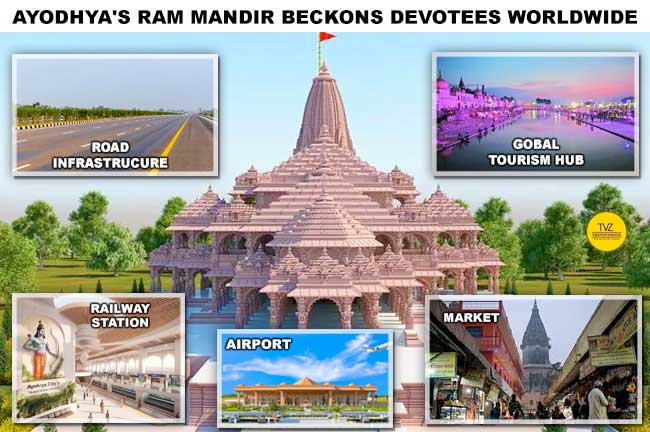
Following the Statue of Unity, Ayodhya Ram Mandir ranks as the second most expensive public monument in recent times. The temple’s hefty price tag has sparked discussions about its implications for UP’s Golden Ticket to Prosperity. The government has articulated strategies to leverage the UP Ram Mandir to promote comprehensive and sustainable development.
Key Developments: UP State Economic Future
- Shri Ram Janmabhoomi Teerth Kshetra: Governed by this trust formed in February 2020, with donations totalling ₹3,500 crore, the construction allocated 51.4% of the funds. The balance amount is in use for maintenance and other activities.
- Tourism and Tax Revenue: The consecration has led to a surge in tourist footfall, propelling UP’s tourism industry towards surpassing the ₹4 lakh crore mark by year-end. Anticipated contributions to tax revenue range from ₹20,000 to ₹25,000 crore.
- Inflows of Investment: The construction has attracted investments from central and state governments and donations from thousands of contributors across the country.
- Economic Ripple Effect: Beyond Ayodhya, the impact extend to neighbouring villages. And foster the growth of small industries and agriculture.

Ayodhya Ram Mandir: Emerges as the Pinnacle of Religious Tourism
The construction of the Ram Mandir in Ayodhya transform the city into the “world’s most sought-after” tourism destination. According to Jaiveer Singh, Tourism Minister, Govt of UP (India), a proposed USD 10 billion makeover of Ayodhya has the potential to draw in more than 50 million tourists annually. Also there is a projections indicating over 100,000 visitors daily to the city. This will boost the economy.
- Local Business Opportunities: Small entrepreneurs benefit from increased demand for accommodations, transportation, food, and various goods and services.
- Boost to Hospitality Sector: The hospitality sector is poise for significant growth, capitalizing on the burgeoning tourism potential.
- Long-term Redevelopment: As per the Master Plan 2031, the state government envisions an investment of ₹85,000 crore over ten years for comprehensive redevelopment.
- Employment Opportunities: The visitor surge generates revenue, create substantial employment opportunities, and foster local businesses.
The Ram Mandir Impact: A Socioeconomic Transformation
The consecration of the Ayodhya Ram Mandir marks the beginning of a new era for the sacred city. Prime Minister Narendra Modi inaugurated projects amounting to Rs 15,000 crore. The projects focus on infrastructure, railways, and the airport. These initiatives aim to bring about a substantial transformation in the region.
Anticipated Gains:
The completion of the Ram Mandir in Ayodhya bring about significant and lasting benefits to Uttar Pradesh:
- Economic Boom: With the potential to attract millions of pilgrims. The Ram Mandir fuels a robust tourism industry, fostering economic prosperity. Local businesses flourish, leading to job creation and economic growth.
- Infrastructure Development: Ayodhya’s transformation includes extensive improvements in roads, railways, airports, and sanitation facilities. This not only caters to the needs of pilgrims but also raises the overall living standards for residents.
- Cultural Renaissance: The construction of the Ram Mandir has ignited a sense of cultural pride, offering the prospect of a revival of traditional art, music, and cuisine in Uttar Pradesh.
- Spiritual Significance: Beyond its religious connotations, the Mandir stands as a symbol of national unity, fostering an environment of peace and harmony.
Unique Aspects:
The Ram Mandir project stands out for several distinctive features:
- Public-Private Partnership: Financed primarily by public donations, the project reflects millions of devotees’ immense faith and dedication. The government plays a crucial role by providing additional resources and facilitating infrastructure development.
- Sustainable Practices: The Mandir Trust commits to incorporate sustainable practices in construction, setting benchmarks for future infrastructure projects.
- Social Impact: Beyond its religious dimensions, the project’s contributions to job creation, economic prosperity, and infrastructure development promise transformative social impact in the region.
The consecration of the Ram Mandir marks a historic milestone. Ayodhya is ready to welcome devotees and pilgrims worldwide, cementing its status as one of India’s holiest cities. The future looks bright for this ancient city as it embraces its role as a beacon of faith.
Global Perspective: Lord Ram Temple Ayodhya
The consecration ceremony of the Ram Mandir Ayodhya elicits global reactions. Fostering hopes for harmony. Leaders worldwide, from the US to the UN, see it as a message of unity and hope.
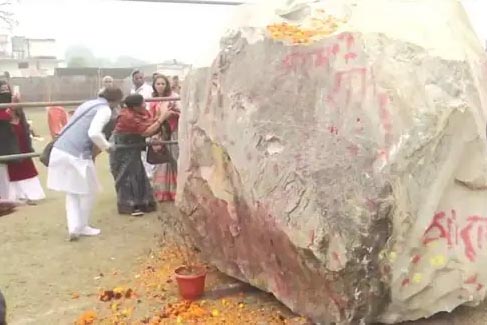
- Nepal’s Gift. The Prime Minister of Nepal extends greetings. Two Shaligram stones, from the banks of the Gandaki River in Nepal, comes to Ayodhya. People rever the sacred Shaligrams as a manifestation of Lord Vishnu. Shri Ram and Janaki idols at UP Ram Mandir is made of Shaligrams
- Thailand. It also symbolically contributed to the inauguration of the Ram Mandir. They honoured the temple by sending soil from Ayutthaya along with water from two rivers in Thailand.
- Indonesia. Religious Leaders in Indonesia welcome the event, seeing it as a symbol of Hindu-Muslim harmony.
- Middle East’s Hope. Leaders in the Middle East hope the Ayodhya Ram Mandir showcases India’s commitment to safeguarding Muslim heritage sites.
- United States. The U.S. acknowledges India’s historic event. US Congressman Shri Thanedar sends across a video message. The “Whole of America”. joins India to celebrate the “Pran Pratishtha” of Ram Mandir in Ayodhya.
- United Nations. Upon arriving in India for the Ram Lalla’s Pran Pratishtha event in Ayodhya, United Nations General Assembly (UNGA) President Dennis Francis expressed delight for “Second Diwali”. He mentioned his anticipation for discussions on peace and growth in the nation.
- Pakistan. Pakistan expresses concerns about potential threats to Muslim heritage sites.
- China. China’s stance emphasizes construction should not impact the existing structure based on mutual understanding.
The global community recognized the temple’s deep significance for Hindus worldwide. Many hoped it would promote interfaith dialogue and harmony.
Ram Mandir Fulfills the Dreams of Millions
For centuries, etched in hearts, not on blueprints, the dream of Ram Mandir stood tall. Now, amidst rising granite and echoing chants, that dream solidifies, brick by sacred brick. Millions who prayed, marched, and yearned to witness their devotion manifest. A towering testament to faith.
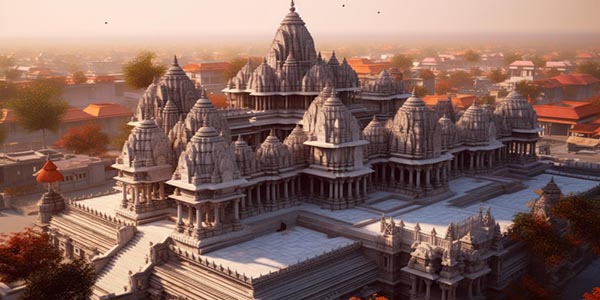
Ayodhya, once scarred by discord, hums with hope. Its ancient soil is blooming with divine promise. In the grand temple’s embrace, the aspirations of countless souls is fulfilled. People of all faiths can celebrate this temple of peace. The temple stands as a monument to craftsmanship. A grand temple is now ready for selfless devotion.
The Ram Mandir is a temple of hope, A temple that will bring people together,
A temple that will help people cope, A temple that will last forever,
The temple fulfils more than a dream. It awakens a spirit of service to humanity and the Divine. Its message is one of wisdom, justice, and unity above all.
Also Read:
- Brew a Better World: The Secrets of Timeless Traditions
- Benefits of Tea: Creating Tranquility in a Busy World
- The Top Social Media Trends You Need to Know for 2024
Ram Mandir Ayodhya: FAQ
The consecration of the Ram Mandir in Ayodhya is a historic event for India. Here are answers to some frequently asked questions about this temple:
When was the foundation stone of Ram Mandir Ayodhya laid?
On August 5, 2020, Prime Minister Narendra Modi performed the Bhoomi Pujan (foundation stone laying) ceremony, marking the start of construction
Who designed the temple?
Chandrakant B Sompura, a 15th-generation architect. He hails from a family legacy responsible for designing over 200 structures. His work includes notable temples like Akshardham, 108 Bhaktivihar, and Somnath temples in Gujarat.
What is Prana Pratistha Ritual at UP Ram Mandir?
Prana Pratistha is the ritual or ceremony in Hindu temples during which a murti is consecrated. At Ram Mandir Ayodhya, Shri Ram Lalla’s Idol was consecrated. It involves reciting hymns and mantras to invite the deity as a resident guest and marks the opening of the murti’s eyes for the first time.
What is the timeline for completion?
he Consecration Ceremony on January 22, 2024, marking the opening of Ayodhya Ram Mandir, concludes a 496-year movement for temple construction. Since the Bhoomi Poojan on August 5, 2020, the on-going construction spans 3 years and 5 months.
Conclusion
Religious tourism of Ram Janmabhoomi, Ayodhya is a pilgrimage. Faio-8912qaZith, history, and cultural harmony reborn. The Ram Mandir Ayodhya consecration ceremony marks a momentous transformation for India.
In the quest for knowledge, people worldwide are eager to uncover the where is Ram mandir located in Ayodhya. Shri Ram Mandir whispers tales of ancient devotion. Echoes with modern technological marvels. And pulsates with the hope of a united future. The revered idol of Ram Lalla, made from the “Krishna Shila”, stands as a testament to modern Indian craftsmanship. Beyond mere bricks and mortar, Lord Ram Temple Ayodhya is an engine for economic prosperity. Yet, its message transcends borders, offering a global call for interfaith harmony and peaceful resolution.
Prana Pratishtha consecrated the idol of Ram Lalla. Millions pour into Ayodhya for religious tourism. This magnificent temple stands ready to embrace devotees. Fulfilled aspirations of countless souls. The UP Ram Mandir is a testament to collective dreams, a beacon of hope, and a symbol of unity.
Lord Ram Temple Ayodhya blesses India and the world into a brighter, more harmonious tomorrow. This temple will uplift generations with its blend of tradition and technology. Let us continue on this progressive path together.
Our Digital Imprints:
Namita Mahajan is a Womenpreneur,
Lifestyle Influencer | Empowering Women Self Reliance
Director: Nuteq Entertainment Pvt Ltd, and
Co-Founder: Trendvisionz – A Premier Digital Marketing Agency in India
Connect with our Newsletters-Transforming Lives. Creating the magic. Just – Believe ~ Practice ~ PerformBizTech Chronicle… Navigating Tomorrow’s Tech Frontiers 🚀
Join my LinkedIn Group: Digital Marketing, Content Creation World Group
Follow me on Twitter or LinkedIn. Check out my website.
